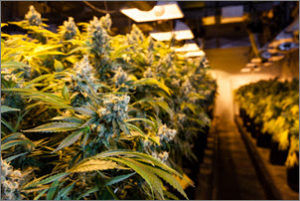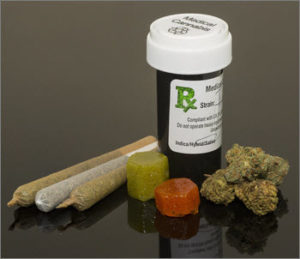I’m often asked to comment on marijuana from a medical perspective, so here goes:
A Few Facts
 The term “marijuana” is for all practical purposes irrelevant and is really an American word for what many other countries refer to as Cannabis. Cannabis Sativa is the strain most often employed for medical purposes. (For simplicity sake in this article, I’ll refer to it as marijuana).
The term “marijuana” is for all practical purposes irrelevant and is really an American word for what many other countries refer to as Cannabis. Cannabis Sativa is the strain most often employed for medical purposes. (For simplicity sake in this article, I’ll refer to it as marijuana).
Cannabis is the most commonly used illicit drug in the United States. As of the November 2016 election, marijuana restrictions have been lifted in several states. Recreational marijuana is now legal in 6 states and the District of Columbia; medical marijuana is now legal in 28 states. From a regulatory perspective, federal law always supersedes state law. Someone can still be arrested and prosecuted for using or possessing medical marijuana – even if it’s legal under state law, but this rarely enforced. The U.S. FDA classifies marijuana as a DEA Schedule I substance primarily because it is the agency’s belief that it has a high potential for abuse, accompanied by questionable safety, even under medical supervision.
How Marijuana Works
The majority of the medicinal value of marijuana is related to its THC (tetrahydrocannabinol) content. THC binds to cannabinoid receptors in the body – producing medicinal and euphoric effects.
Medical Uses
Why use marijuana, when there are so many legal medications available for what it claims to treat? Detractors claim it’s all about getting high and dissociating from reality. Supporters, on the other hand, say that it’s not about getting high because there are bona fide symptoms and conditions for which marijuana is effective. Also, so supporters say, marijuana is a better option than addictive narcotics with unpleasant side effects.
Some Clinical Evidence of Efficacy
Certain mental disorders (anxiety in particular); sleep disorders; neurological issues; some cancers; glaucoma
Solid Clinical Evidence of Efficacy
Management of nausea and vomiting associated with chemotherapy; appetite stimulation associated with body wasting; treatment of muscle spasticity
Impressive Efficacy
Seizure management; pain control; slowing the growth of certain cancers
Marijuana Consumption
 Smoking is of course most common, producing rapid intoxication with deep inhalation. Long-term use via the smoking route is linked to chronic bronchitis, cough, phlegm production and respiratory tract infections. Marijuana is routinely consumed orally via laced foods and beverages such as brownies, candies, cookies, and teas. It can also be used by vaporizer, which burns the marijuana at a lower temperature than when smoked – releasing THC from the plant with ostensibly fewer harmful side effects.
Smoking is of course most common, producing rapid intoxication with deep inhalation. Long-term use via the smoking route is linked to chronic bronchitis, cough, phlegm production and respiratory tract infections. Marijuana is routinely consumed orally via laced foods and beverages such as brownies, candies, cookies, and teas. It can also be used by vaporizer, which burns the marijuana at a lower temperature than when smoked – releasing THC from the plant with ostensibly fewer harmful side effects.
Risk Factors
Is marijuana addictive? This depends largely upon how the word “addiction” is defined. Reliable and trustworthy sources that I implicitly trust indicate that 91percent of users develop NO problems related to marijuana addiction. Caveat: It’s not just a property of a substance that determines a substance-use disorder regarding cannabis or anything else; it’s the properties of the individual – genetics, biology, multiple psychosocial factors.
Risk of psychosis? For the majority of users, such risk is very low. Age-related risks? Absolutely yes, with potential harm highest among children and adolescents. Chronic use in this population group leads to distinctive adverse effects on brain development and cognitive dysfunction – with adverse effects on IQ. The IQ effects are generally related only to those who started smoking prior to age 18.
Potential Negative Consequences
Withdrawal symptoms from regular use do occur, with marijuana detox in a heavy user lasting an average of 3-5 days, accompanied by marked irritability, insomnia, headache, nausea and vomiting.
Regular use is associated with time distortion, hallucinations, tachycardia, chronic sleepiness, impaired memory, poor problem-solving skills, amotivational syndrome and a marked lack of success in school and career.
Smoking while driving is well…Cheech and Chong-like; judgment and perception are impaired; fatalities, arrests and DUIs are common with the highest risk period in the 1st hour after lighting up.
My Take on Medical Marijuana Use
It’s superior in seizure management; excellent in managing chemo-induced nausea and vomiting, treating glaucoma and appetite enhancement.
As for treating chronic pain, I’m more suspicious, because it’s difficult for me to determine whether marijuana truly has analgesic effects versus merely minimizing the perception of pain via its euphoric and dissociative effects.
Finally, I can’t think of any psychiatric disorder for which I would recommend marijuana. None.
Attribution Statement:
Joe Wegmann is a licensed pharmacist & clinical social worker has presented psychopharmacology seminars to over 10,000 healthcare professionals in 46 states, and maintains an active psychotherapy practice specializing in the treatment of depression and anxiety. He is the author of Psychopharmacology: Straight Talk on Mental Health Medications, published by PESI, Inc.
To learn more about Joe’s programs, visit the Programs section of this website or contribute a question for Joe to answer in a future article: joe@thepharmatherapist.com.